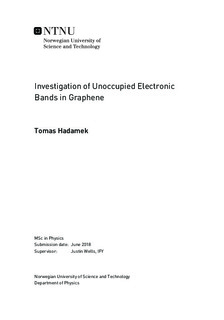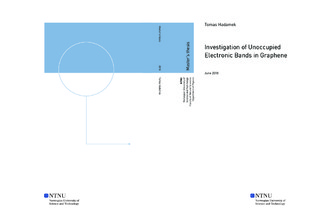| dc.description.abstract | In recent years, a lot attention has been paid to various two-dimensional materials due to their unique properties stemming from the spacial refinement of one of the material's dimensions. Regardless of the incredible theoretical and experimental attention on graphene, unoccupied electronic bands are not yet well understood and there is a wealth of contradictory information in the literature about the band origin.
In this thesis, unoccupied electronic graphene states are investigated with a special focus on the lowest unoccupied bands rising from the valence atomic orbitals ($2s$, $2p_x$ and $2p_z$) localized in the graphene layer, known as the $\sigma^*$ states. As a tool for the unoccupied band structure study, an inverse photoemission spectroscopy, is utilized.
To theoretically predict the spectrum which can be expected from measurements of the $\sigma^*$ bands, graphene band structure is calculated from a tight-binding model. The so-called "three step model" is used and together with a dipole and free-electron initial state approximation results in the expected inverse photoemission spectrum. In order to account for possible many-body effects which are present in the occupied electronic bands and which can also be expected in the unoccupied electronic bands, electron-phonon coupling is included in the model.
A characterization of the NTNU laboratory inverse photoemission apparatus reveals the resolution being too poor for the intended measurements. The final experiment is performed at Physikalisches Institut, Münster, and shows a single electronic band about 3.5\,eV above the Fermi level. The intensity of the measured peak is found to be non-vanishing at normal electron incidence which contradicts the calculated spectrum. The width of the peak and its position with respect to the vacuum level suggest that this peak originates from the two lowest graphene image-potential states which questions previously published inverse photoemission measurements. | |

